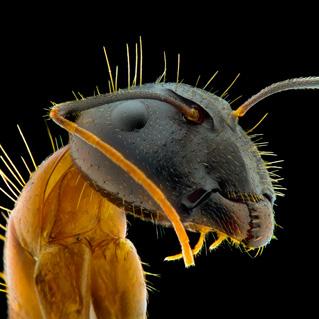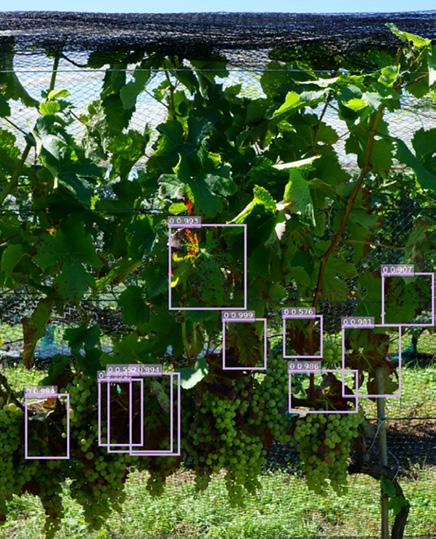
5 minute read
AI — virtual orchards, insect superpowers and intelligent computer vision
from Segment magazine 2
Artificial Intelligence (AI) is the study of computations that make it possible to perceive, reason, and act. AI can enable machines to do jobs that have traditionally required human intelligence. The development and training of AI algorithms often requires some form of human input, but once established these algorithms can increase our capacity to accurately predict and classify information at a much larger scale than is possible using humans, and in much less time.
One of the most important requirements needed to train a robust AI model is a reliable source of high quality data. For sciencebased AI applications, novel methods are often developed just to capture the high quality data needed to train the algorithm. The AI algorithm is then trained and assessed by leveraging expert knowledge within a particular field to determine how well the AI application performed its desired task.
Advertisement
Virtual orchards
Managing an orchard of the future may be more about understanding its digital twin. With advances in capturing data — including panoramic, infrared, light detection and ranging (LIDAR) and magnetic resonance imaging (MRI) — it is possible to obtain accurate 3D data in just a day or two.
But why create a virtual orchard when you have the real thing? Capturing virtual data at various stages of plant development within and between seasons can support decision-making around investment and cultivar development and help quantify environmental impacts. As sustainable producers of horticultural products, the technology could support New Zealand’s growers. Data on nutrient demand, water and disease gleaned from a virtual orchard can reduce the cost of actions in the real orchard — including preventing negative impacts on the environment. Such data can also assist in forecasting the impacts of environmental changes.
Real-time data can also be used for selection in breeding programmes, maximising the available information for analysis, which can be too resource intensive to collect in the real orchard. And, unlike real orchards, virtual orchards are captured forever. So the data can be stored and revisited at future points in time as new research questions arise.

If this all sounds simple enough, developing AI for orchard or vineyard management is not. It requires massive quantities of robust data and the development of sophisticated models of the orchard system.
“The ability to virtualise spatial data of plants on a whole-orchard scale, coupled with improvements in augmented reality, will massively improve our ability to access, interact with, and understand complex information about our plants,” says Dr Peter McAtee, Plant & Food Research Scientist.
McAtee has been working on using AI technology for the past three years and says, “It signifies a step change that will be similar to when we moved from paper to computer-based recording of information. Researchers can expect to see some exciting advances in this field in the not-sodistant future”.
Harnessing insect superpowers
Insects are known for their incredible sense of smell. Consider how long it takes them to discover uncovered food.
As Dr Andrew Kralicek, Chief Technology Officer, Scentian Bio, says, “Insects’ primary sense is smell. 400 million years of insect evolution has made them incredibly sensitive to volatile organic compounds.”
He should know — having spent close to two decades searching for a way to harness this amazing sense of smell for human use.
Insects derive their smell superpower from their smell receptors. Combining insect smell receptors with state-of-the-art biosensor formats, Kralicek and his team have developed a prototype sensor that enables synthetic insect receptors to be used to detect tiny quantities of volatile compounds. Their technology has the capacity to revolutionise electronic sensors as we currently know them, detecting volatile organic compounds down to the parts per quadrillion level. But it has to be taught how to smell, which is where AI comes in.
Developing the technology involves pairing sensor chips with machine learning algorithms. In this way the smell receptors are ‘translated’ using AI into digital information about target aromas and flavours. This pairing of the sensor chip with AI means many sensors can be put onto a single chip to detect a range of compounds in a single sample, based on the digital signals produced. The chips can be integrated into existing sensor platforms or used for new devices and applications.
The potential applications are enormous. On the list are: detecting cancer, identifying pest incursions, checking air and food quality, alcoholic beverage production and even detecting explosives.
Kralicek and his team are taking their technology into commercial development, with the goal of developing novel sensors for specific uses. These hand-held, selective and highly sensitive sensors will provide a cost-effective alternative to current sensing technologies like gas chromatography-mass spectrometry (GC-MS). The potential applications are enormous. On the list are: detecting cancer, identifying pest incursions, checking air and food quality, alcoholic beverage production and even detecting explosives.

Intelligent computer vision
Manually identifying, counting and measuring plants, insects or sea creatures for horticultural and aquacultural applications can be enormously time consuming. Training computer models to do this job quickly and reliably allows more time to be spent analysing datasets and less time collecting them. It can also enable entirely new data collection methods that weren’t previously possible.
Data Scientists at Plant & Food Research, Daniel Bentall and Harris Lin, have developed an intelligent computer vision platform aiming to make computer vision more accessible and affordable, which is suited to a range of applications.
“To enable the automation of image recognition, images first need to be annotated by people. The annotations are used to train a machine learning model how to perform the task,” says Bentall.
The platform can perform a range of tasks such as counting objects, detecting disease or estimating size, and has many potential applications, including for phenotyping, monitoring and crop management. So far it has been applied to projects like detecting leafroll disease in grapes, counting kiwifruit on vines and tracking growth of pea seedlings.

Intelligent computer vision detecting leafroll disease in grapes.










